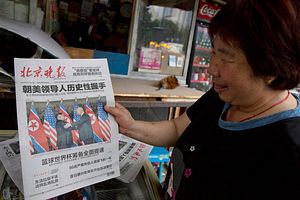When Kim Jong Un arrived in Singapore for his historic summit with U.S. President Donald Trump, the North Korean leader was riding in an Air China plane. As Washington Post reporter Anna Fifeld pointed out, the front page of Rodong Sinmum included an image of Kim embarking on the plane with the Chinese flag clearly visible on the aircraft body. It was a visual reminder that, though no Chinese officials took part in the summit, Beijing still loomed large.
When Trump first agreed to meet with Kim back in March, catching the world off-guard, China seemed oddly out of the loop. Since then, however, Kim has traveled to China to meet with Chinese President Xi Jinping on two separate occasions, alongside other high-level exchanges. Whatever concerns Beijing may have had about being sidelined have been addressed.
In fact, during his post-summit press conference, Trump took the time to praise “a very special person, President Xi of China” at some length for his role in making the Trump-Kim meeting possible. Xi is “a terrific person and a friend of mine, and really a great leader of his people,” Trump gushed, before adding, “I want to thank them for their efforts to help us get to this very historic day.”
Later in the press conference, Trump clarified that the United States was “working with China” on filling in the details of the commitments made in the U.S.-North Korea joint statement, albeit “to a lesser extent” than Washington’s coordination with Seoul and Tokyo. When asked specifically about a potential Chinese role in a still-hypothetical peace treaty with North Korea, Trump gave a typically facile response:
I’d like to have them involved also. There’s a question as to whether or not we’re supposed to or whether or not we legally have to. I don’t care. I think it would be great to have China involved and also, of course, South Korea.
As Chinese officials have been quick to point out, during the course of the latest developments, China’s two main proposals for dealing with the North Korea issue have been essentially adopted (although, importantly, neither the United States nor North Korea has framed the moves as a response to China’s long-standing suggestions).
First, China’s “dual freeze” idea called for halts to both North Korea’s nuclear and missile programs and U.S.-South Korea joint military exercises. In April, Pyongyang announced a moratorium on nuclear and missile testing, even demolishing tunnels at its Punggye-ri nuclear test site before a crowd of international reporters. On Tuesday, Trump announced – apparently without first consulting with South Korea – that the United States would be ending what he called “war games” with South Korea, saying that the military exercises were “inappropriate,” “provocative.” and “tremendously expensive.” With that, the “dual freeze” is essentially in force.
Second, China has long proposed a “parallel track” of negotiations, whereby progress on denuclearization occurs alongside separate talks on normalizing U.S.-North Korea relations and cementing a formal peace treaty. That too is in the works now, with the joint statement issued after the Trump-Kim summit noting commitments to “new U.S.-DPRK relations,” building “a lasting and stable peace regime on the Korean Peninsula,” and “complete denuclearization of the Korean Peninsula” in separate points.
Accordingly, Chinese Foreign Ministry spokesperson Geng Shuang noted in his press conference on Tuesday that now both the “dual freeze” and “parallel track” proposals were in the process of being enacted.
Overall, China has a lot to be pleased with. The Trump-Kim summit lowered tensions without a sea change in the status quo, and Beijing has every reason to expect it will be included in more substantial talks on a peace agreement, as per Trump’s own statement. It’s no surprise then that a statement from the Chinese Ministry of Foreign Affairs on the summit began by noting the “positive results.” The statement also praised the “political decisiveness” of both leaders and expressed China’s “welcoming and support” for the outcomes. The current situation, the statement added, “is in agreement with China’s hopes.”
The statement also noted that China is a neighbor to the Korean Peninsula and an important actor on Korean issues, and promised to continue Chinese efforts to “realize denuclearization of the peninsula and create a peninsular peace mechanism.”
The big question now is what exactly China’s role moving forward will look like – a question Geng evaded answering in detail several times during Tuesday’s press conference. In particular, it has been widespread speculation that China will seek to reward North Korea for its behavior thus far by loosening enforcement of UN sanctions.
When asked about the possibility of sanctions being scaled back, Geng emphasized that China “has always earnestly and strictly implemented every resolution on North Korea passed by the Security Council.” However, he also suggested that changes to the sanctions regime could be made based on North Korea’s own actions, if and when it complies with previous UNSC resolutions.
“The Security Council’s action should support and correspond to the current efforts toward diplomatic dialogue and denuclearization of the peninsula,” Geng said.
As for next steps, Geng refused to specify whether or not Kim would stop over in China on his way home for meetings with Chinese officials. U.S. Secretary of State Mike Pompeo is scheduled to visit China on June 14 to discuss the summit, among other issues.

































